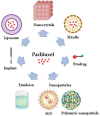Paclitaxel Drug Delivery Systems: Focus on Nanocrystals' Surface Modifications
- PMID: 35215570
- PMCID: PMC8875890
- DOI: 10.3390/polym14040658
Paclitaxel Drug Delivery Systems: Focus on Nanocrystals' Surface Modifications
Abstract
Paclitaxel (PTX) is a chemotherapeutic agent that belongs to the taxane family and which was approved to treat various kinds of cancers including breast cancer, ovarian cancer, advanced non-small-cell lung cancer, and acquired immunodeficiency syndrome (AIDS)-related Kaposi's sarcoma. Several delivery systems for PTX have been developed to enhance its solubility and pharmacological properties involving liposomes, nanoparticles, microparticles, micelles, cosolvent methods, and the complexation with cyclodextrins and other materials that are summarized in this article. Specifically, this review discusses deeply the developed paclitaxel nanocrystal formulations. As PTX is a hydrophobic drug with inferior water solubility properties, which are improved a lot by nanocrystal formulation. Based on that, many studies employed nano-crystallization techniques not only to improve the oral delivery of PTX, but IV, intraperitoneal (IP), and local and intertumoral delivery systems were also developed. Additionally, superior and interesting properties of PTX NCs were achieved by performing additional modifications to the NCs, such as stabilization with surfactants and coating with polymers. This review summarizes these delivery systems by shedding light on their route of administration, the methods used in the preparation and modifications, the in vitro or in vivo models used, and the advantages obtained based on the developed formulations.
Keywords: cancer; chemotherapy; drug delivery; nanocrystals; nanotechnology; paclitaxel; surface modification.
Conflict of interest statement
The authors declare no conflict of interest.
Figures
Similar articles
-
Hydroxypropyl Beta Cyclodextrin as a Potential Surface Modifier for Paclitaxel Nanocrystals.AAPS PharmSciTech. 2022 Aug 9;23(6):219. doi: 10.1208/s12249-022-02373-y. AAPS PharmSciTech. 2022. PMID: 35945468
-
Development of stabilized Paclitaxel nanocrystals: In-vitro and in-vivo efficacy studies.Eur J Pharm Sci. 2015 Mar 10;69:51-60. doi: 10.1016/j.ejps.2014.11.012. Epub 2015 Jan 2. Eur J Pharm Sci. 2015. PMID: 25559064
-
Paclitaxel formulations: challenges and novel delivery options.Curr Drug Deliv. 2014;11(6):666-86. doi: 10.2174/1567201811666140609154949. Curr Drug Deliv. 2014. PMID: 24909147 Review.
-
Nanoparticles of biodegradable polymers for clinical administration of paclitaxel.Curr Med Chem. 2004 Feb;11(4):413-24. doi: 10.2174/0929867043455909. Curr Med Chem. 2004. PMID: 14965222
-
Recent Development of Copolymeric Nano-Drug Delivery System for Paclitaxel.Anticancer Agents Med Chem. 2020;20(18):2169-2189. doi: 10.2174/1871520620666200719001038. Anticancer Agents Med Chem. 2020. PMID: 32682385 Review.
Cited by
-
Formulation and evaluation of cetuximab functionalized phospholipid modified nanocrystals of paclitaxel for non-small cell lung cancer therapy.Sci Rep. 2024 Nov 24;14(1):29114. doi: 10.1038/s41598-024-80283-8. Sci Rep. 2024. PMID: 39582089 Free PMC article.
-
Formononetin-Loaded PLGA Large Porous Microparticles via Intratracheal Instillation for Bleomycin-Induced Pulmonary Fibrosis Treatment.AAPS PharmSciTech. 2025 Apr 17;26(5):112. doi: 10.1208/s12249-025-03089-5. AAPS PharmSciTech. 2025. PMID: 40246731
-
Package delivered: folate receptor-mediated transporters in cancer therapy and diagnosis.Chem Sci. 2024 Jan 17;15(6):1966-2006. doi: 10.1039/d3sc05539f. eCollection 2024 Feb 7. Chem Sci. 2024. PMID: 38332833 Free PMC article. Review.
-
Implantable Polymer Scaffolds Loaded with Paclitaxel-Cyclodextrin Complexes for Post-Breast Cancer Tissue Reconstruction.Polymers (Basel). 2025 Feb 3;17(3):402. doi: 10.3390/polym17030402. Polymers (Basel). 2025. PMID: 39940603 Free PMC article.
-
Sustained Drug Release from Dual-Responsive Hydrogels for Local Cancer Chemo-Photothermal Therapy.Macromol Biosci. 2025 Mar;25(3):e2400413. doi: 10.1002/mabi.202400413. Epub 2024 Nov 20. Macromol Biosci. 2025. PMID: 39565793 Free PMC article.
References
-
- WHO Cancer-Fact Fheets. [(accessed on 2 March 2020)]. Available online: www.who.int/mediacentre/factsheets/fs297/en/12/9/20182/3/2020.
-
- World Health Organization. [(accessed on 5 March 2021)]. Available online: https://www.who.int/news-room/fact-sheets/detail/cancer.
Publication types
LinkOut - more resources
Full Text Sources
Research Materials



